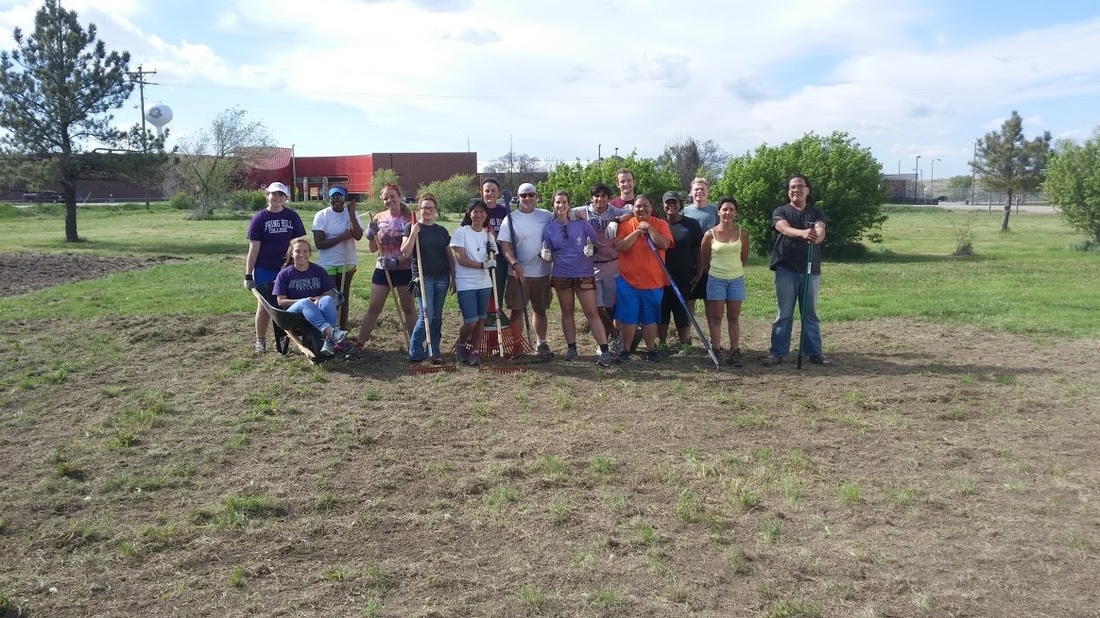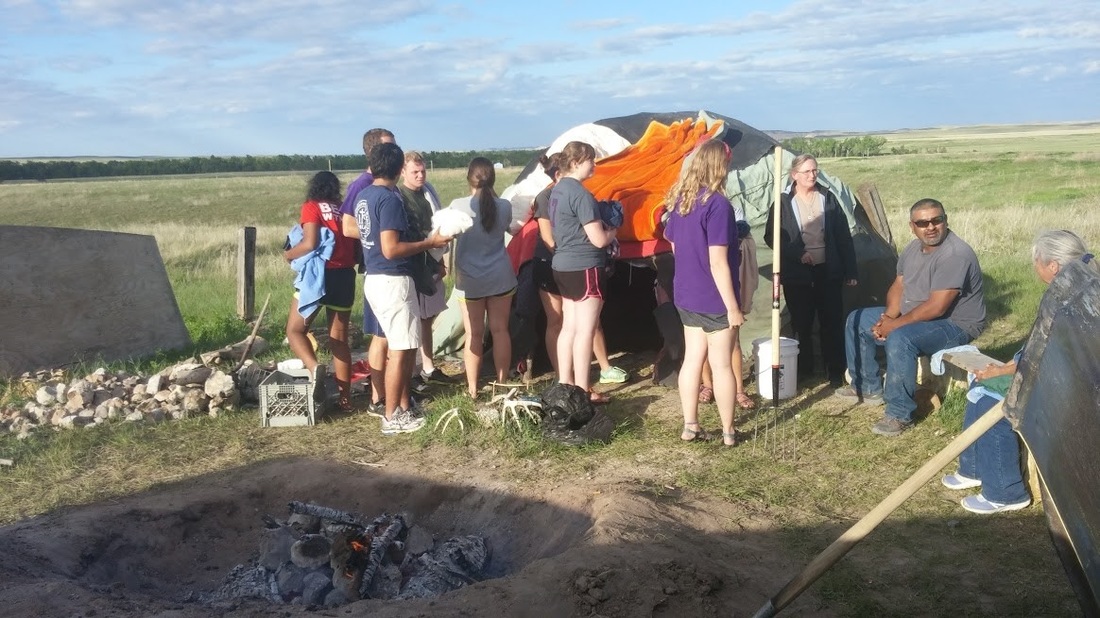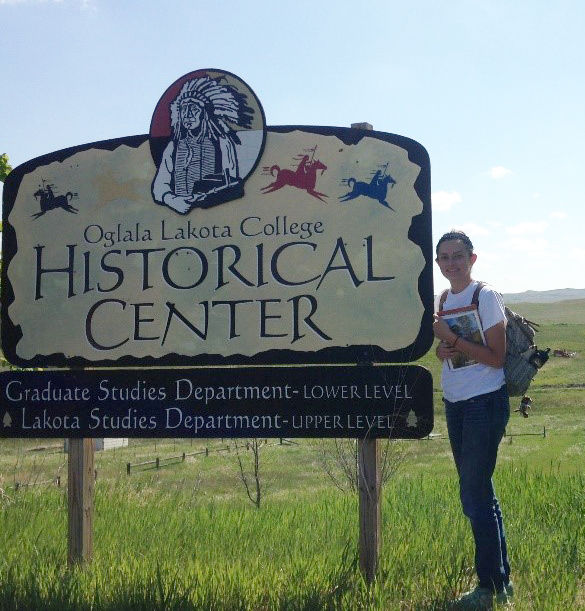
It was dark and I was groggy, but I still couldn’t help notice the beautiful lights of the Rapid City skyline. On the car ride, when I wasn’t dozing off, I was admiring the serene Badlands and rolling hills. When we arrived to Our Lady of Sorrows, we were greeted by Father Rick and Larry, our hosts. Father Rick would also be the one to show us around the Pine Ridge Reservation and introduce us to Lakota natives. That night, we didn’t go to sleep till midnight, despite having to wake up bright and early the next day to start our service project: a community garden for Kyle, the brainchild of Lakota community leader Patricia, on the Our Lady of Sorrows Church grounds. Aside from learning the Lakota culture and the Native American plight, we learned to live simply. Considering ten girls had to share one shower, we showered quickly. We maximized space for sixteen people staying in a five-bedroom home, and we learned to be resourceful, stretching food to accommodate us all. Groups of us would take turns cooking dinner and cleaning up the kitchen, though, one night, we had the option of not cooking at all. We were offered a big pot of Buffalo soup made by Kyle residents. It tasted like regular meat, except more tender.
On our first day of work in the garden, we were greeted by two friends of Patricia. On that day, we also messed up some of Patricia’s schematics. The garden would encompass a plot of land behind the church, a bit of the left side of the church, and a bit of the right side of the storage building to the left of the church. They had already begun tilling the land behind the church, but it wasn’t to Patricia’s dimensions. So, we tilled it some more, but were quickly approaching the parameters of a propane tank. Thus, we decided to expand the plot by length rather than width when Patricia’s plans requested vice versa. That day, we also began digging four holes on each corner of the plot, where the posts for the fence would go. We began clearing the shrubbery on the side of the church and storage building, then tilling the area with hoes. We had a tiller, but only one, and it was being used on the plot of land behind the church. During our lunch break, some of the girls and I walked around and explored. We passed by and admired the architecture of Little Wound School, whose graduation ceremony we would go to the following night—there, we would learn the importance and symbolism of the Eagle feather on graduation caps. And we walked down to the American Recovery and Reinvestment Act of 2009 provided neighborhood on New Housing Road.
Aside from learning the Lakota culture and the Native American plight, we learned to live simply.
 My service group and I pose with Patricia (in the light green tank top) and her team after a day of garden work. (Courtesy Colleen Lee)
My service group and I pose with Patricia (in the light green tank top) and her team after a day of garden work. (Courtesy Colleen Lee)
On our second day of work, Patricia arrived and with details of the garden’s functionality and layout. On the plot of land behind the church, food would be planted for self-sufficiency. On the side of the church and storage building, flowers would be planted for aesthetic value. Underneath a tree by the storage building, a bench would be placed so residents could sit down and admire the view. Together, these elements would create a safe-space and sense of responsibility for Kyle residents. As Patricia explained during our lunch break the day she arrived, the Native American dependency on the government was created by the government itself. It began with the systematic genocide and removal of Native Americans during westward expansion. This was further backed by the virtual tour we went on at Oglala Lakota College, where we learned of Red Cloud, the Wounded Knee Massacre, and the forced assimilation of Native Americans. As a result of this dependency, many Native American reservations lack resources (medical, technological, manufactural, etc.) and heavily import their food. Patricia wants Kyle residents to produce and maintain their own food. Further, she wants the garden to be an alternative to destructive decisions, where residents can gather safely and happily. She explained how the dependency has also affected the psyches of residents. Residents have turned to alcohol, drugs, and suicide due to mental and emotional instability—but this is true for most of the Pine Ridge Reservation and most reservations across the country.
We saw the evidence for ourselves when we cleaned the picnic area across from the church and found around thirty empty vodka bottles strewn around. Then, we heard stories of families affected by alcohol, drugs, and suicide through the community leaders Father Rick introduced us to. After Patricia, the second strongest and most independent woman I met on the reservation was Mary, a basketball coach at Isna Wica Owayawa Loneman School. She is raising five nieces and nephews due to alcohol. She spoke of it with a melancholy twinge, but then lit up when she spoke of her oldest nephew, Dylan. She had that same expression when we went to his graduation at Red Cloud Indian School a few days later. I thought it was just the regular excitement of a parent whose child is about to graduate, but it was more than that. Now, I know it was the relief and pride of a parent whose child has beat the odds—one where Native American teens are expected to be high school dropouts.
Following our introduction to Mary, we went to Red Cloud Indian School, where we were given a tour of the grounds by Rilda. She took us to the Heritage Center, where we walked around its museum and shopped at its gift shop, and Holy Rosary Church, where we basked in the intricate Lakota stained-glass windows and baptismal font that had survived a fire. From Rilda, we learned of the school’s well-deserved prestige. For example, there is a waitlist to enroll and the school has had fifty-nine students earn the Bill and Melinda Gates Millennium Scholarship. Rilda’s little brother (Dave) is even one of those Gates scholars, and the day we went to the school’s graduation ceremony, five seniors were recognized with having received the scholarship. We would later return to the school to participate in a group discussion with Red Cloud educators and graduates on education and conditions on the reservation.
On the night we met Lance and went to his horse ranch, we learned more about suicide on the reservation. Lance is a horse trainer and basically the community therapist. In his younger days, he was one of the fastest runners in the country; however, an invitation to meet the Pope threw him off his training process and made him plateau. Now, he counsels residents with suicidal thoughts, depression, alcohol abuse, etc., through leading interactions between them and his horses. He’s helped curb suicides on the reservation, but not entirely. That night, he told us a twelve-year-old had recently committed suicide. A feeling of distress loomed for the rest of the night and didn’t go away, not even after Lance’s son sang us beautiful, traditional Lakota songs.
 My service group members and I wait for Sam to finish heating up the rocks for the sweat lodge ceremony. He is the one seated with the sunglasses. (Courtesy Colleen Lee)
My service group members and I wait for Sam to finish heating up the rocks for the sweat lodge ceremony. He is the one seated with the sunglasses. (Courtesy Colleen Lee)
After our sit down with Tamatane, we headed to Sam’s house for the sweat lodge ceremony. Those who wanted to and could participate went. Those who could not participate were women menstruating or pregnant. The exclusion isn’t sexist based, rather spiritually based. In the Lakota culture, sweat lodge ceremonies are meant to cleanse its participants. And since Lakota natives believe menstruation and pregnancy is a time of cleansing, there’s no need for a dual cleanse. When we arrived to Sam’s home, we found him burning rocks in the middle of a pit and talking to a white-haired woman seated to the left of him. Behind him was the sweat lodge, composed of tied, dome-shaped tree limbs covered with several blankets and duvets. We would later find out that the blankets and duvets would be for containing the heat and dark—no amount of light would go so far as to peak through. While we waited for the ceremony to start, we struck up a conversation with the white-haired woman. I’ve forgotten her name, but not her story. She told us about her long drive to the Pine Ridge Reservation, her hunt to identify her birth parents (she believes they were Lakota natives), and her spiritual experience at Crazy Horse memorial monument. Then, it was time for the ceremony to start. To accommodate the nine of us, Sam, Sam’s two kids, and the white-haired lady, we all sat crossed leg within the sweat lodge. In the middle was another pit and the freshly hot rocks, closely accompanied by a bucket of water. The way it works is that water is dumped on the rocks to create steam and heat. During the ceremony, Sam went easy on us. He didn’t make it as hot and long as normal sweat lodge sessions are. We also learned a few Lakota terms during that time. We learned to say Tagashala (“god”), wopila (“thank you”), and Aho Mitakuye Oyasin (“all my relations”). The thing I remember most, though, is how Sam made us feel spiritually connected, despite our religious differences. He wouldn’t let us forget that although we may have different practices, we still worship the same god.
Before we knew it, our departure date was a day away. So, we spent Saturday completing our work in the garden. We finished tilling the land behind the church, planted flowers in their respective spots, raked the leaves, built a flower bed, and customized two concrete stepping stones for the garden (one that says “All my Relations” and another “SHC 2016”). At our work’s completion, we were relieved, yet dismal. After we said our goodbyes to Patricia and her team, the weight of the week hit us full force. We had learned many things and seen many things, but we had unknowingly helped build something, too. Yes, we had helped build a garden, but we had also helped build hope.
Lance is a horse trainer and basically the community therapist. In his younger days, he was one of the fastest runners in the country; however, an invitation to meet the Pope threw him off his training process and made him plateau. Now, he counsels residents with suicidal thoughts, depression, alcohol abuse, etc., through leading interactions between them and his horses.
- http://www.edweek.org/ew/projects/2013/native-american-education/running-in-place.html with accompanying video documentary: http://www.edweek.org/ew/projects/2013/native-american-education/a-long-road-back-to-rez-video.html (Has Mary and Rilda discussing education on the reservation)
- http://www.redcloudschool.org/news/201600502/a-moment-of-joy-five-red-cloud-indian-school-seniors-earn-the-2016-gates-millennium-scholarship (about the Gates scholars in the 2016 graduating class of Red Cloud Indian School)
- https://www.youtube.com/watch?v=HD5GPBRsJcQ (Ted Talk by Peter Hill, language coordinator of the Lakota Language Immersion Childcare)
- http://www.redcloudschool.org/reservation (statistics about the Pine Ridge Reservation)
AuthorMarian Cook is a Journalism major and French minor at Spring Hill College in Mobile, AL. When she’s not obsessing over science fiction books, she’s obsessing over science fiction movies. She loves Boston Terriers and frogs a little too much. And she likes to call herself an adventurer even though she won’t leave her house for days on end sometimes. She currently lives in Tuscaloosa, but one day hopes to return to her hometown, Managua, Nicaragua. |



 RSS Feed
RSS Feed